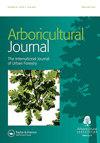Issues of trees, health, and risks
Q3 Agricultural and Biological Sciences
引用次数: 0
Abstract
In this issue of the Arboricultural Journal the discussion of approaches and methods for tree valuation continues with particular but by no means exclusive relevance to amenity trees and trees in urban environments. There will be more on this important and controversial topic in future issues. Barrell (2021) considers how the complex process of tree risk management is applied to balance the benefits from trees and harm which may arise from proximity to people and property; a situation especially prevalent in urban settings. The level of management that the legal institutions, such as courts demand of duty holders, is continually subject to review and clarification. This process is driven by advances in technical knowledge and practical experience and through the societal insights of legal judgements and inquests. In this context, if they are to successfully avoid criticism and liability in the event of tree failure that leads to harm, then duty holders responsible for tree safety need to regularly review and adapt to the changing landscape of practice and litigation. This review considers implications from three recent developments which might have a bearing on how the courts assess tree risk management. Firstly, Barrell examines the civil case of Cavanagh v Witley Parish Council & Shepherd. In this example, the resultant High Court Appeal raised questions concerning inspection frequency and occupancy. Secondly, there have been two recent inquests which raised the importance of proactive management of highway trees (and hence a topic which today is never far from the headlines). Thirdly, there is the growing threat from millions of dying trees with ash dieback disease in particular and probably with globalisation and climate change, from other diseases too. Usefully the paper suggests a new model to incorporate such factors into strategic tree risk management with, for duty holders, two revised decisionmaking frameworks. Tree risks and failures are often connected to high winds and so our enhanced understanding of wind and its behaviour is always welcome. Goodwin (2021) addresses daily maximum high gust wind speeds at Dublin, Ireland. The study takes and analyses data from a recent 30-year period. In the research, the maximal and mean storm gusts were compared to those of the growing season. The work considers xylogenesis in a context of thigmomorphogenetic acclimation of temperate trees to the experienced wind environment. Considering notional minimal factors of biomechanical safety and major tree failures in storm winds, maximal annual gust probabilities were estimated. The correlation of the highest mean growing season gusts and extremum storm gusts is then reviewed. From the analysis, the successful acclimation to the mean highest 5% of growing season gusts was suggested to give a notional minimal factor of safety against major failure in extremum winter storm gusts of about four. From this study it is inferred that tree risk assessment might place more emphasis on factors of inadaptation which Arboricultural Journal 2021, VOL. 43, NO. 1, 1–2 https://doi.org/10.1080/03071375.2021.1898817树木、健康和风险的问题
在本期的《树木学杂志》中,继续讨论树木价值评估的方法和方法,特别是但绝不是唯一与城市环境中的美化树和树木有关。在以后的文章中会有更多关于这个重要而有争议的话题。Barrell(2021)考虑了如何应用树木风险管理的复杂过程来平衡树木的好处和可能因接近人和财产而产生的危害;在城市环境中特别普遍的情况。诸如法院等法律机构要求义务持有人的管理水平不断受到审查和澄清。这一过程是由技术知识和实践经验的进步以及法律判决和调查的社会见解推动的。在这种情况下,如果他们要成功地避免在树木失败导致伤害的情况下受到批评和承担责任,那么负责树木安全的义务持有人需要定期审查并适应不断变化的实践和诉讼环境。本综述考虑了可能对法院如何评估树木风险管理产生影响的三个最新发展的影响。首先,Barrell考察了Cavanagh v Witley Parish Council & Shepherd的民事案件。在这个例子中,高等法院的上诉提出了有关检查频率和占用的问题。其次,最近有两项调查提出了主动管理公路树木的重要性(因此,这个话题今天永远不会远离头条新闻)。第三,数以百万计的枯死树木的威胁越来越大,尤其是白蜡树枯死病,可能还有全球化和气候变化,以及其他疾病。有用的是,本文提出了一个新的模型,将这些因素纳入战略树木风险管理,为责任持有人,两个修订的决策框架。树木的风险和故障通常与大风有关,因此我们对风及其行为的进一步了解总是受欢迎的。古德温(2021)记录了爱尔兰都柏林的每日最高阵风风速。这项研究收集并分析了最近30年的数据。在研究中,将最大阵风和平均阵风与生长季节的阵风进行了比较。这项工作考虑了在温带树木对风环境的同种形态发生驯化的背景下的木质学。考虑最小生物力学安全因素和主要树木在风暴中的破坏,估计了最大年阵风概率。然后回顾了生长季节最高平均阵风与极端风暴阵风的相关性。从分析中,成功适应生长季节平均最高5%的阵风,建议提供一个最小的安全系数,以防止在极端冬季风暴阵风中发生重大失败,约为4。从这项研究可以推断,树木风险评估可能更侧重于不适应因素。1,1 - 2 https://doi.org/10.1080/03071375.2021.1898817
本文章由计算机程序翻译,如有差异,请以英文原文为准。
求助全文
约1分钟内获得全文
求助全文
来源期刊

Arboricultural Journal
Agricultural and Biological Sciences-Agronomy and Crop Science
CiteScore
2.40
自引率
0.00%
发文量
28
期刊介绍:
The Arboricultural Journal is published and issued free to members* of the Arboricultural Association. It contains valuable technical, research and scientific information about all aspects of arboriculture.
 求助内容:
求助内容: 应助结果提醒方式:
应助结果提醒方式:


